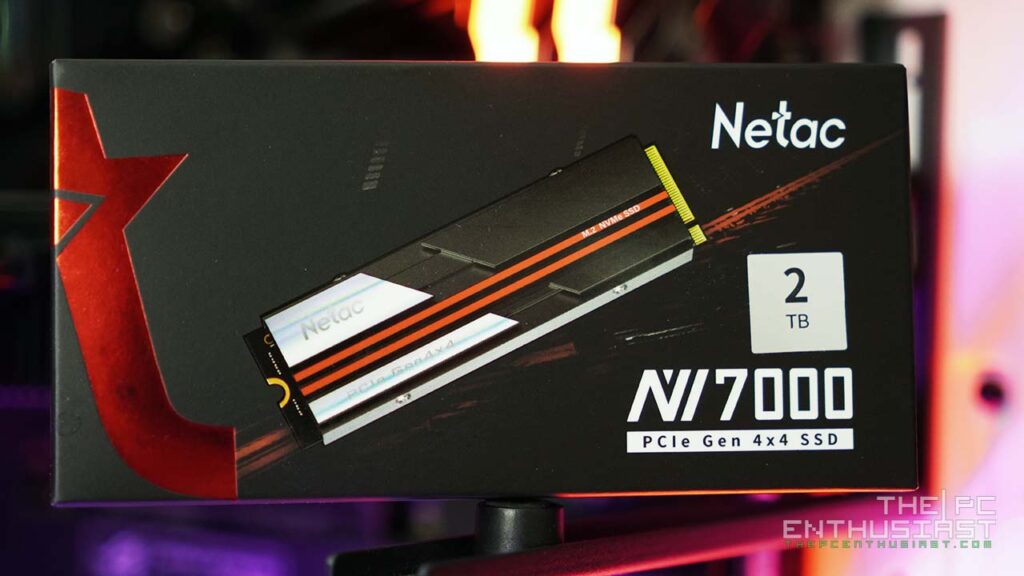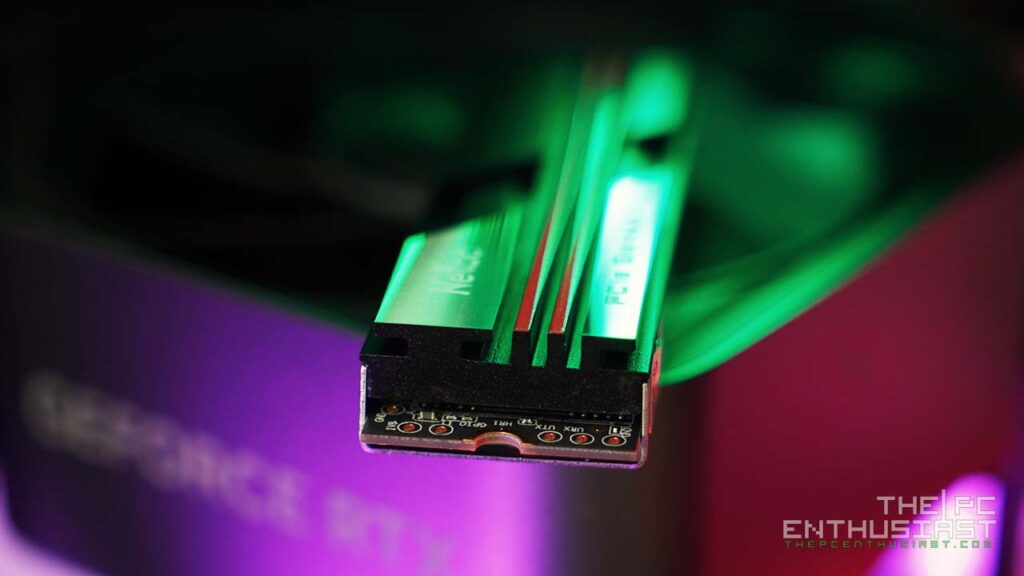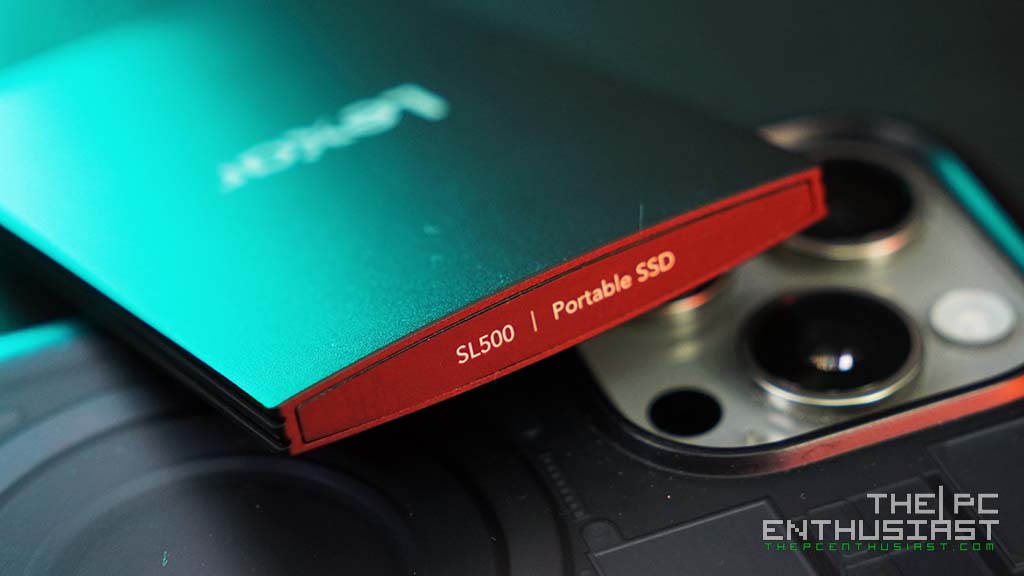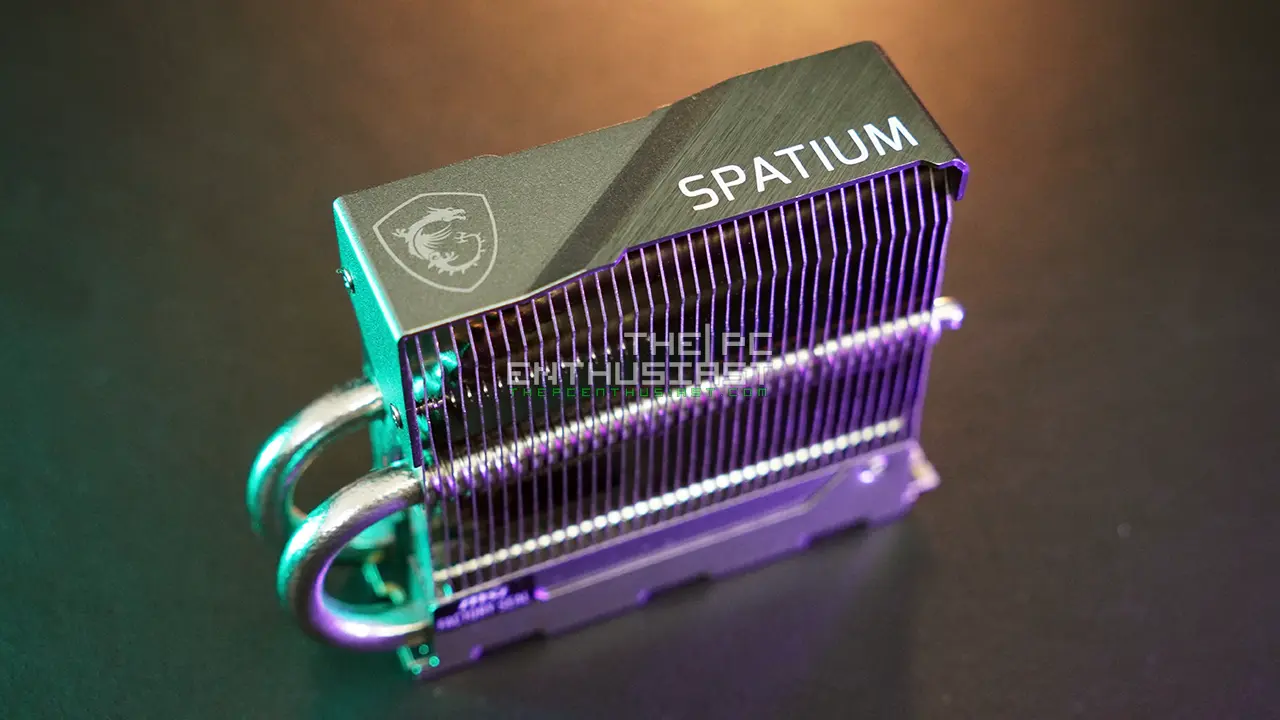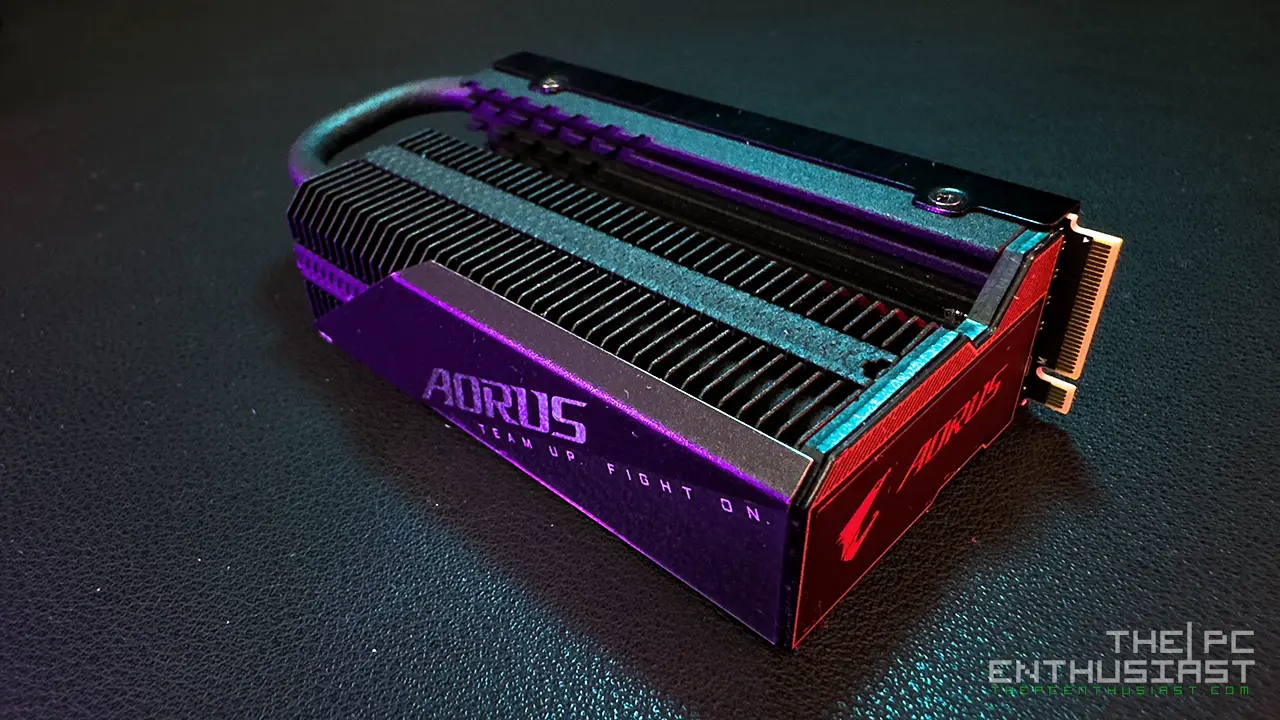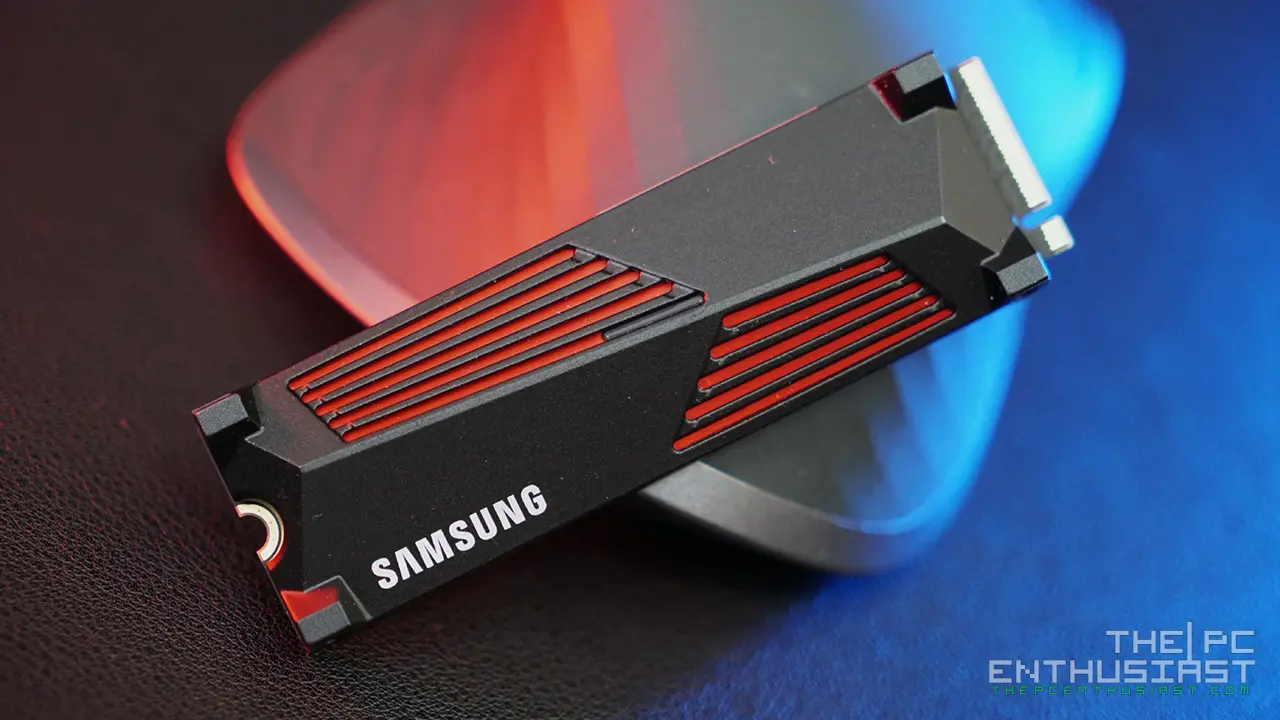Today, let’s look at an M.2 NVME SSD from a company you may not be familiar with. I have here the NV7000 PCIe 4.0 NVMe M.2 SSD from a company called Netac. The NV7000 Gen4 SSD offers sequential speeds of up to 7,200MB/s read, and 6,800MB/s write. It also features a good-looking aluminum heatsink. The Netac NV7000 is not only made for desktop PC applications, but it is also compatible with the PS5. Please continue reading our Netac N7000 review and learn more about the product.

Netac NV7000 PCIe Gen4 NVMe M.2 SSD Review
You might not have heard of Netac before. But Netac Technologies has been around since 1999. Mostly, they do OEM business, and recently they have been making strides in the DIY market as well.
Established in 1999, Netac supplies products and solutions in global flash applications. It has four wholly-owned subsidiaries: Beijing Netac Innovation Technology Development Co., Ltd., Shenzhen Langsheng Electronics Co., Ltd., Leapro Technology Co., Ltd., and Netac Technology (Hong Kong) Limited.
In 2010, Netac was successfully listed on the A-share Growth Enterprise Market. Today, the company focuses on manufacturing flash memory products, such as Solid State drives, Portable SSD, DDR, and mobile storage products.
Packaging and Closer Look
The Netac NV7000 came with a small rectangular box. You can see an image of the drive at the front as well as the capacity of the SSD. There’s not much information on the back, except for the drive’s product and serial number, and oddly the line “PCIE Gen4.0x4 Supports NVMe 1.4” in several languages.
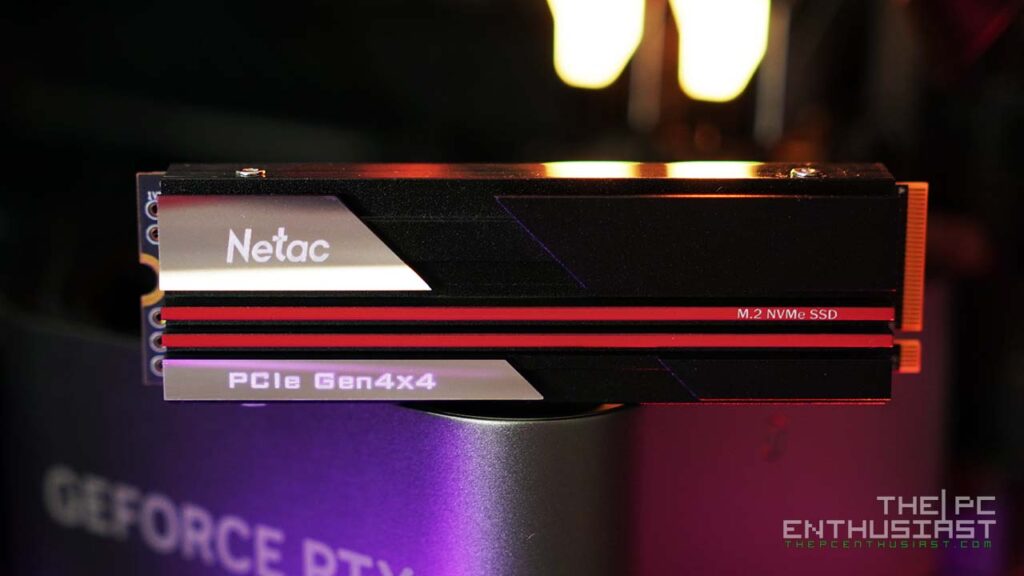

At the front, the NV7000 features a good-looking heatsink. The aluminum heatsink has a two-tone color scheme with two red lines as a highlight. The bottom of the NV7000 is a plate that holds and fastens the (top) aluminum block. You can also see some information about the product underneath.
The NV700 has a simple and straightforward design. No complicated patterns or oversized heatsink. Just a simple aluminum block with lines to give it some highlight. Netac has to keep the heatsink at a specific size so that it would fit in the PS5. After all, the NV7000 is compatible with the PS5.
I wanted to open the NV7000, see what’s under the hood, and take photos of the chips. Unfortunately, one of the Torx screws was stripped. I can’t unscrew it anymore. I resorted to reviews on the web to see which components were used inside. And this is when I realized I had stumbled into a rabbit hole (sort of).
The Rabbit Hole (somewhat)
When I searched for NV7000 reviews, I noticed that the specs on their review differ from other reviewers. For example, TechPowerUp’s NV7000 sample uses a Phison PS5018-E18 with Micron 176-layer 3D TLC NAND. Meanwhile, most NV7000 samples, especially reviews published this year, use InnoGrit Rainer IG5236 with YMTC 128-layer TLC NAND.
Interestingly, Guru3D’s unit uses the InnoGrit IG5236 controller, but with Micron NAND flash. I’m not sure if Guru3D’s reviewer got the memory part wrong since there was no photo of the NV7000’s PCB. Nevertheless, regardless of configuration, all seem to be using an SKHynix DDR4 for its DRAM.
My NV7000 samples came from China, and I think it is the one with the InnoGrit IG5236 controller and maybe with the YMTC 3D NAND. However, I can’t say 100% for sure. But the layout on the top portion, near the M.2 fingers, looks similar to that of the NV7000 with the InnoGrit controller.
So, which one’s which?
Unfortunately, there’s no way to tell if the NV7000 uses a Phison E18 controller with Micron NAND or an InnoGrit controller and YMTC NAND. While the Product Number is similar regardless of the controller, the serial number seems to be different; at least based on the different reviews I checked.
Unlike other SSD companies, Netac doesn’t indicate or mention which controller and NAND flash are used on the NV7000’s marketing materials or website. It just says 3D NAND flash, and there is no word about the controller.
Perhaps, Netac previously used Phison and Micron on their NV7000 and decided to switch to InnoGrit and YMTC later. As for the reason why, I have no idea. Anyway, let’s see how this drive performs.
Netac NV7000 Specifications
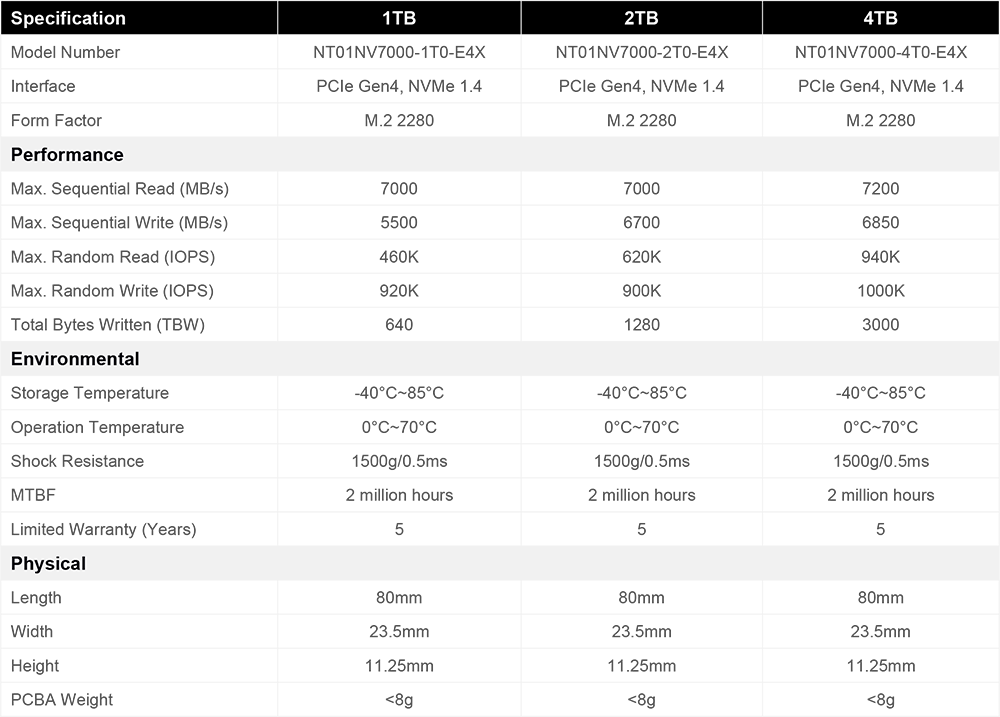
Check the latest pricing and availability: (#ad)
Netac NV7000 M.2 SSD is available on Amazon.com here.
Test Setup
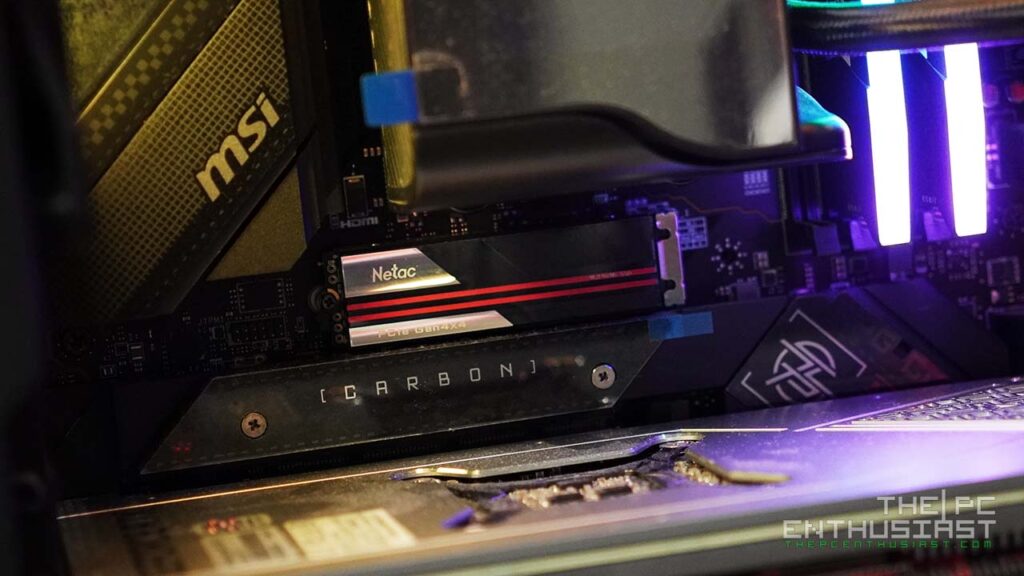
I tested the Netac NV7000 2TB capacity on an X670E motherboard with an AMD Ryzen 7 7700X. I installed the drive on the first M.2 slot. The first M.2 slot, located just below the CPU socket, is connected to the CPU. Below are the rest of the system’s specifications:
| Operating System | Windows 11 Pro |
| Processor | AMD Ryzen 7 7700X |
| Motherboard | MSI MPG X670E Carbon WiFi |
| Memory | Corsair Vengeance RGB DDR5-6000MHz CL30 AMD EXPO |
| Graphics Card | Colorful GeForce RTX 4070 Ti iGame Advanced |
| OS Drive | MSI Spatium M480 Play |
| Game Drive | SanDisk Extreme PRO Portable SSD V2 and Extreme Portable SSD V2 |
| Power Supply | MSI MPG A1000G PCIE5 |
| Chassis | MSI MPG Velox 100P Airflow |
| Monitor | MSI Optix MPG321UR-QD 4K 144Hz |
Nectac NV7000 SSD 2TB Benchmark Results
AJA Benchmark Results
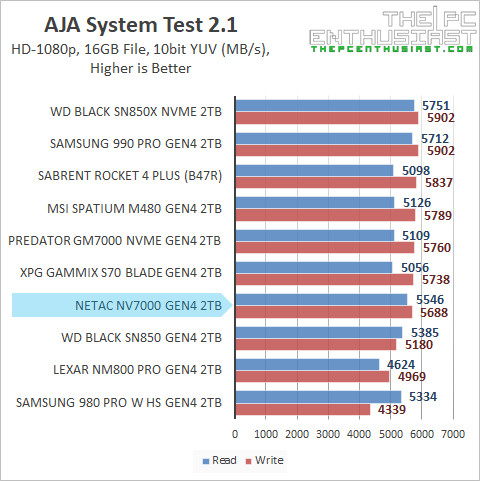
In the AJA System Test benchmark, Netac’s NV7000 performed similarly to the other Gen7 SSDs rated at around 7,000MB/s. It’s basically neck and neck with other drives. It’s also worth mentioning that its read speed is slightly faster than the other drives.
AS SSD Benchmark Results

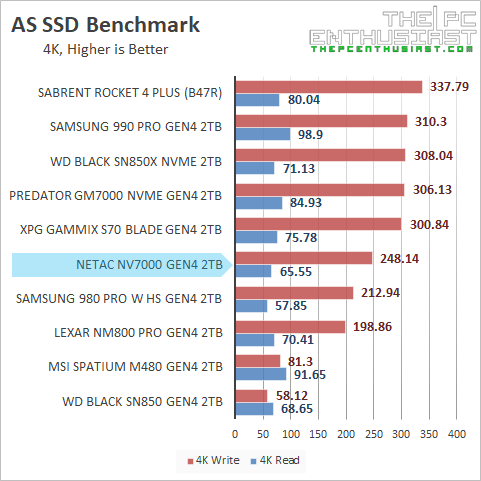
I’m surprised that the Netac NV7000 came on top at AS SSD’s sequential test. It got a sequential write speed of 5,980MB/s and a sequential read speed of 6,210MB/s. While it is not far from the other SSDs, its sequential performance is commendable.
When it comes to random performance, this is where most SSDs tend to struggle; and the NV7000 is no exception. While it performed well during sequential workloads, its random performance is just okay; it’s not the fastest out there.
ATTO Disk Benchmark Results
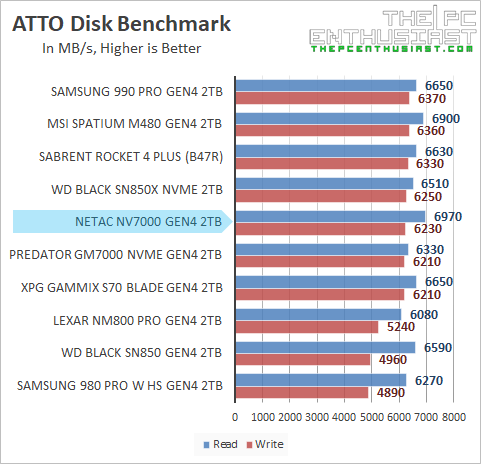
ATTO Disk benchmark is purely a sequential test, and again we can see that the NV7000 performed well during sequential read. By the way, all the graphs are sorted according to write speeds.
The NV7000 has an advertised sequential read speed of 7,200MB/s and a sequential write speed of 6,800MB/s. I don’t expect these drives to hit their advertised speeds because they don’t usually. And sometimes, it also depends on the system used. But I expect they would at least get read/write speeds near or close to the advertised speeds. In this case, the NV7000 is close to its advertised sequential speeds.
CrystalDiskMark Benchmark Results
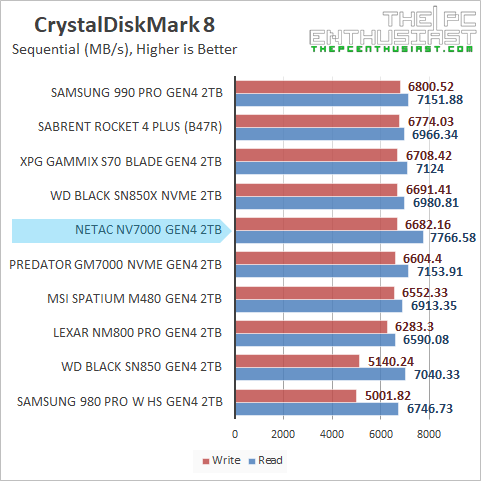

In CrystalDiskMark, we can see a similar pattern or behavior. The NV7000’s sequential read performance is impressive, and its sequential write is just where it is expected. Generally, it’s not the fastest drive, but it’s not on the bottom either. Even its random performance is good overall relative to the other SSDs.
PCMark 10 Full System Drive Benchmark Results
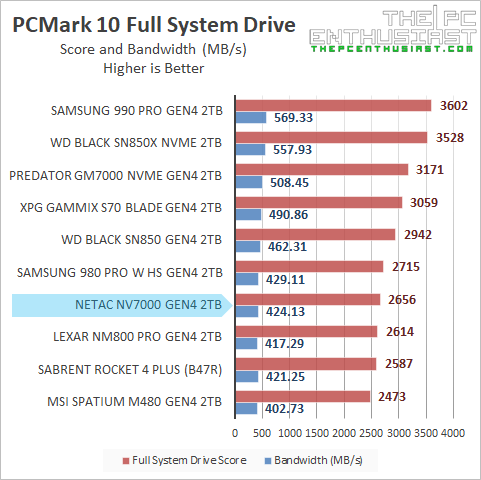

Lastly, I tested the Netac’s NV7000 2TB SSD using the PCMark 10 Full System drive benchmark suite. It is an intensive test and takes about an hour (or more) to finish. The test uses a wide-ranging set of real-world traces from popular applications (Adobe Creative Suite, Microsoft Office), and common tasks to test the performance of modern drives thoroughly.
In this test, the NV7000 was not at the top of the chart. It is somewhere in the middle. I expected it to match the XPG Gammix S70 Blade since that drive also uses an Innogrit controller. However, the NV700 ended up just below the (old) Samsung 980 Pro and slightly above the Lexar NM800 Pro. By the way, the Lexar NM800 Pro also uses an Innogrit IG5236 controller.
Based on my results, the NV7000 is generally a good SSD. But performance is not the ultimate deciding factor alone. Price plays a huge role as well.
Pricing and Availability
The Netac NV7000 PCIe 4.0 M.2 SSD series is now available in the US. At the time this review was published, it retailed for $94.99 (1TB), $140.99 (2TB), and $388.99 (4TB). SSD prices tend to change frequently, so for the latest pricing and availability, kindly check the links below.
Check the latest pricing and availability: (#ad)
Netac NV7000 M.2 SSD is available on Amazon.com here.
Other M.2 SSDs with Heatsink are available on Amazon.com here.
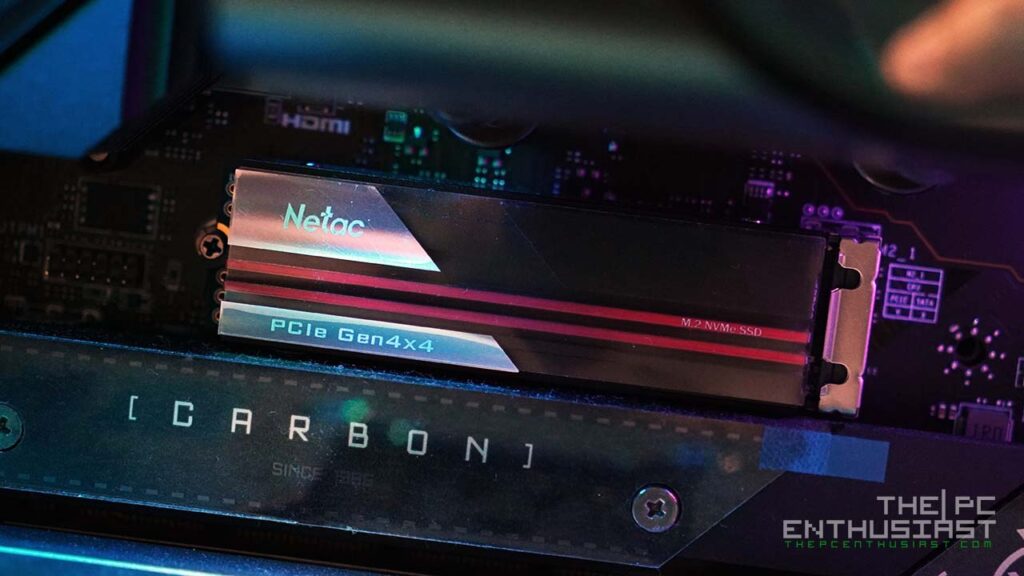
Netac NV7000 M.2 SSD Review Conclusion
Performance-wise, Netac’s NV7000 performs as expected. It’s not a top-performer SSD, like the Samsung 990 Pro, but it is no slouch either. Its performance is within specs or close to the advertised speeds, and it should work well in both desktop PC and PS5 applications.
Aesthetically speaking, the NV7000 looks good as well. It has a simple heatsink design, yet the two red lines are enough to catch your attention. I don’t have an issue with its performance or how the drive looks. But I do have some concerns regarding its main components.
My Only Concern
Netac doesn’t mention whether the NV7000 primarily uses a Phison controller or Innogrit. And the same can be said with what type of NAND flash they used. Maybe the early NV7000 SSDs were based on a Phison controller with Micron NAND. But they later switched to Innogrit with YMTC 128L TLC. Ah, could this be the old bait and switch? I am not sure.
I have tested several SSDs that are using an Innogrit controller. So far, I don’t have any major or critical issues with Innogrit-based SSDs. They perform as expected and can compete with Phison-based SSDs. However, I am not familiar with the YMTC NAND flash. This is the first I encountered or heard of this brand. While its performance checks out, I’m a bit skeptical about its reliability or longevity.
Finally
At the end of the day, the NV7000 performs as advertised, regardless of its internal components. However, while it performs as expected, it must also compete in pricing. Currently, several M.2 SSDs (with heatsink) from top brands have their drives on a discount or markdown. It would be much easier to recommend the NV7000 if the price is competitive or cheaper than the competition. If you catch the NV7000 at an attractive price, you may want to add this to your shortlist.


